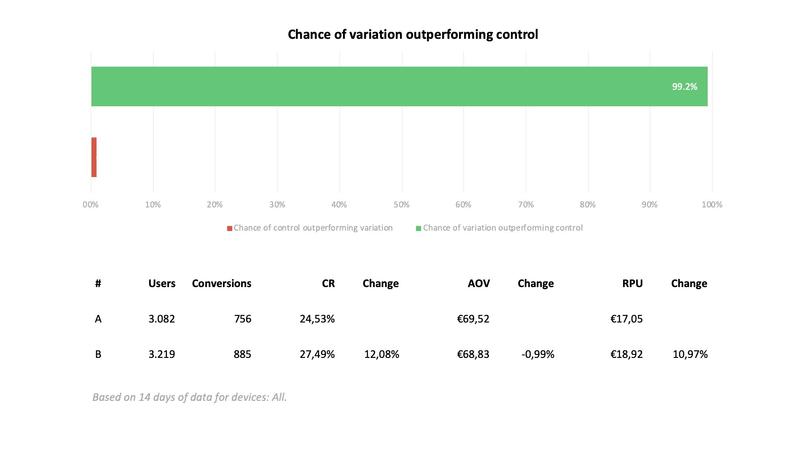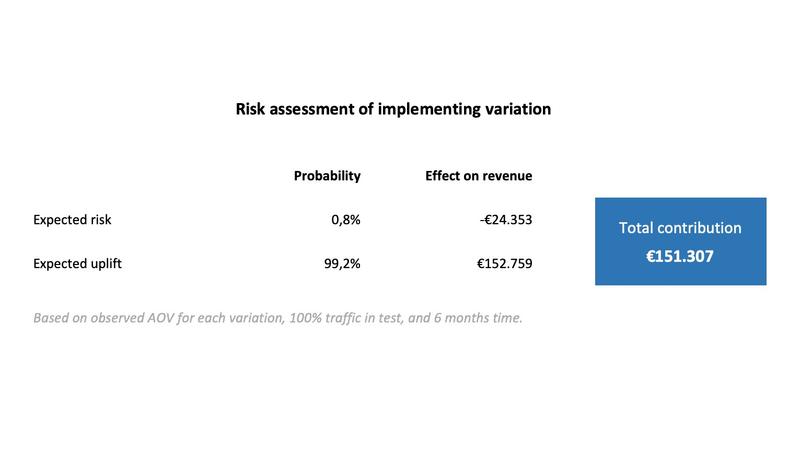With A/B testing you use a scientific approach to investigate which changes on your website or webshop lead to more conversions. This allows you, for example, to improve the conversion rate and thus increase turnover.
Do you recognize this?
- A lot of money goes to SEA and SEO, but the results are below expectations
- You do have an A/B testing tool, but you don't do enough with it
- Conversion optimization does not 'live' within the organization
And want the following?
- A structured approach to conversion optimization
- Based on valid, reliable, and significant AB tests
- Designed, set up and run by an experienced a/b testing specialist
€10 million+ in annual recurring revenue generated for customers
Highlighted benefits of A/B testing
Fixed costs per A/B test → No surprises afterwards
We agree on the costs per test in advance. These costs include the following activities: Communicating, researching, prioritizing, devising, building, implementing, checking, launching, monitoring, analyzing, reporting and documenting. No hassle with hours of estimates for me and no surprises for you afterwards, it's a pleasure to work together.
Structured process → More results
Recent research by RedEye shows that companies with a structured CRO process achieve better results. That is why we use a well-thought-out process to run every A/B test. Current A/B tests, test ideas and results are of course all tracked in a structured manner.
Extensive reports → Better learnings
The test reports contain statistically well-substantiated recommendations based on the A/B test results. Advanced techniques such as Monte Carlo simulations are also used to predict the impact of a test on turnover. Clear visuals and management summary then make the reporting accessible and valuable to all stakeholders.
Frequently asked questions
Can't we just set up A/B tests ourselves?
No, in any case not A/B testing where the results are valid and reliable. Nowadays, every online marketer or front-end developer can easily set up an AB test in one of the well-known A/B testing tools. However, without knowledge of issues such as sample size, significance, power, flickering, hypotheses and heuristics, the outcome will most likely be useless. A/B tests whose results you can rely on therefore require an expert.
Is my website suitable for AB testing?
It is possible to run AB tests on almost all websites (including web shops on popular platforms such as Magento, WooCommerce and Shopify). As a rule of thumb, a minimum of approximately 1,000 conversions (transactions, leads, donations, etc.) per month is used. So-called MVT (multivariate) tests even require much higher numbers of conversions. If you are far below the recommended number of conversions, AB testing is probably not the best solution to improve your website. In that case, a website analysis or user testing may yield a better return.
Which A/B testing tools are you familiar with?
I have extensive hands-on experience with setting up A/B tests in almost all known A/B testing tools. In total, this concerns several hundred tests that have been set up in Google Optimize, Convert, VWO, Adobe Target, SiteSpect, AB Tasty, and Optimizely. If you happen to use another testing tool, this is no problem. Because A/B testing tools are ultimately very similar in principle, valid and reliable tests can be set up with that tool in no time.
Who will build the A/B tests?
In the vast majority of cases, I will be able to build the devised A/B tests myself. I then place the JavaScript and CSS code with which the tests were built in the testing tool so that the variants can be compared against the control. Exceptions to the foregoing are tests for which information from the backend is required in the A/B test. Consider, for example, tests in which the prices of products are tested to determine whether new input fields need to be added to a form.
How is progress documented?
All experiments are tracked in a so-called A/B testing roadmap. The experiments are each assigned a status here, such as test idea, planned, or completed. This roadmap has been developed as a Google Sheets document. This makes it easy to provide various stakeholders (such as product owners, web builders, managers, and online marketers) with insight into which AB tests are live on the website. An additional advantage of using Google Sheets is that there are no monthly costs.
How much additional turnover does AB testing generate?
This amount of additional turnover depends on several factors. Logically consider the current turnover, but also, for example, the amount of tests that are run per month, to what extent the hypotheses for these AB tests are substantiated with research such as user tests, how well the AB tests are built, etc. However, it certainly happens that a single AB test increases revenue per user by > 10%.
Interested in A/B testing for your organization?





















